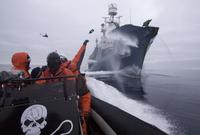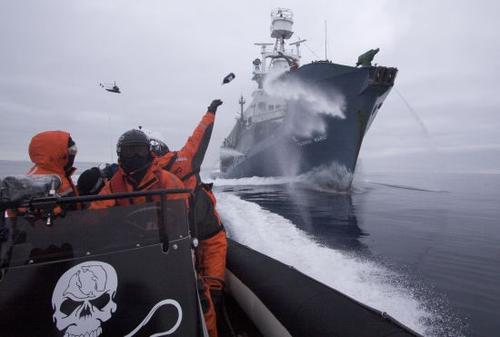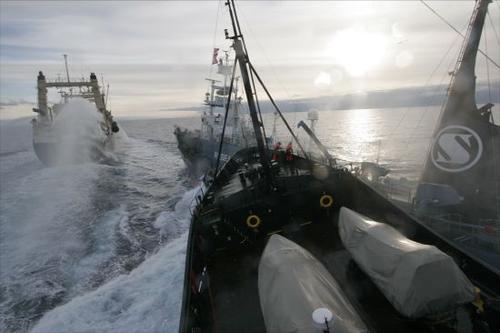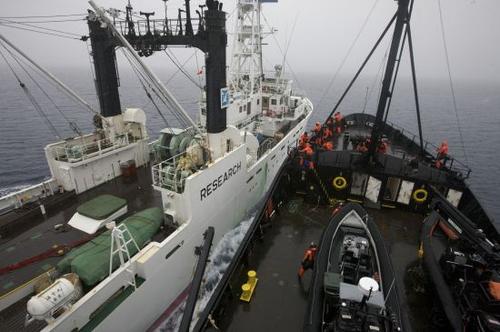The Whale Wars – Sea Shepherd Returns From Antarctica¶

The flagship of the Sea Shepherd Conservation Society, the M/Y Steve Irwin, is heading back from the Antarctic Whale Sanctuary where it has been on patrol to enforce international conservation regulations in protection of the area’s great whales. Since its departure from Brisbane, Australia on December 4th, the ship and its crew have been involved in various confrontations with a Japanese Whaling Fleet, which continues to operate a commercial whale hunt in the area illegally.
On December 26th, the Steve Irwin confronted the Japanese vessel Kaiko Maru. The ships collided and Sea Shepherd crew deployed butyric acid on its decks. From 1st February the whaling operation was shut down for 8 days straight with both sides of the conflict accusing each other of dangerous manoeuvres and tactics. On February 6th, the Steve Irwin collided with a harpoon ship twice, when it tried to block the ship from offloading a dead whale onto the factory ship Nisshin Maru. As part of an international crew of volunteers, 3 activists from the UK worked onboard the Sea Shepherd vessel during the campaign which was dubbed operation Musashi.
Photos: Photo Report – Onboard Sea Shepherd Operation Musashi | Videos: Ramming the Japanese whaling ship – Sea Shepherd | Sea Shepherd collides with whaling harpoon ship (Indybay)
On The Newswire: Sea Shepherd Forced To Leave Killing Grounds In Antarctica | Ramming the Japanese whaling ship, onboard the Steve Irwin | Sea Shepherd blames acoustic weapon attack for Ramming Whaling ship | Japanese Whalers Playing Dangerous Games in the Ross Sea | Sound weapons used against protestors | Whalers harassed by Sea Shepherd in Australian Antarctic waters | Whalers flee Sea Shepherd in Southern Ocean Whale Sanctuary
Previous Features: Japan issues arrest warrant for Nottingham activist | Arrests As International Whaling Commission Fails To Protect Whales | Nottingham Activist Returns From Whale Saving Mission In Antartica | Sea Shepherd activists injured as Japanese military open fire | Activists Held Hostage By Japanese Whalers In Southern Ocean | Whalers use Public Relations to twist the truth
Links: Sea Shepherd Conservation Society | Institute For Cetacean Research (Japanese pro-whaling PR) | Ocean Defence Topic page

Boat crew deploy butyric acid on a harpoon ship. Photo: Adam Lau/Sea Shepherd

Steve Irwin collides with Japanese harpoon ship. Photo: Adam Lau/Sea Shepherd

Steve Irwin collides with whaling spotter ship. Photo: Eric Cheng/Sea Shepherd
On December 19th, only 9 days after the Steve Irwin had left Hobart, Tasmania it was able to locate one of the ships of the Japanese Whaling Fleet. The Yushin Maru No.2, one of the Japanese harpoon ships, suffered ice damage to its propeller while being pursued by the Steve Irwin that day. In dense fog the harpoon ship was forced to flee into icy waters. The incident and the damage which resulted from it took the harpoon vessel out of operation between December 20th and February 5th, for a total of 46 days.
On December 26th, the Steve Irwin confronted the Japanese spotter vessel Kaiko Maru. The ships collided and Sea Shepherd crew deployed butyric acid on its decks. During manoeuvres by both ships a collision occurred causing minor damage to both ships, and no injuries, in Antarctic waters within the Australian Economic Exclusion Zone and Southern Ocean Whale Sanctuary, north of the Mawson Peninsula. Australian citizen Jeff Hansen from Perth, Western Australia, delivered a message over the radio in Japanese calling on the Japanese whaling ship to cease whaling operations and leave Australian territorial waters.
The Kaiko Maru had been undertaking a detour in the ice pack area after completing the day’s research activities, according to the Institute Of Cetacean Research (ICA). The Steve Irwin pursued and came alongside the Kaiko Maru for anti-whaling activists to throw 10 bottles of butyric acid (rotten butter) and 15 bottles of a methyl cellulose and indelible dye mixture.
Methyl cellulose makes the decks of the whaling ships unbearably slippery, as the whalers now know after a few of these confrontations, while butyric acid produces a very bad smell making work intolerable. Both substances are biodegradable and cause no harm when it comes in contact with a person. The main target is the large deck of the Nisshin Maru, the factory ship which processes the whale meat. Once the substances have been thrown on deck, they can’t use it for a while as it would contaminate the whale meat, delaying any killing of whales.
From 1st February the whaling operation was shut down for 8 days straight as Sea Shepherd persued the factory ship Nisshin Maru. On February 4th, Sea Shepherd reported that the three harpoon vessels of the fleet attacked the Steve Irwin. All three harpoon ships moved in to flank the Steve Irwin as the Sea Shepherd ship continued to chase the factory ship Nisshin Maru. “The Yushin Maru #2 initiated the attack by cutting dangerously close across the bow of the Steve Irwin from port to starboard in seas that were far from calm. The other two harpoon vessels Yushin Maru #1 and Yushin Maru #3 made the same dangerous maneuvers.” stated a press release by Sea Shepherd. “It has given us some very dramatic footage for the next season of Whale Wars,” said Captain Paul Watson.
“If their intention was to intimidate us, it did not work. When it comes to playing chicken on the high seas, we have much more experience than the whalers.”¶
On February 6th, the Steve Irwin collided with a harpoon ship twice, when they tried to block it from offloading a dead whale onto the factory ship Nisshin Maru. No injuries occurred during the collision. The Japanese Whaling fleet decided to stop running from Sea Shepherd and recommenced whale slaughtering which has provoked confrontations between the whalers and Sea Shepherd activists.
According to Captain Paul Watson: “We told them to not continue their illegal whaling operations and that we would be blocking the stern slipway of the factory ship. They decided to test our resolve and apparently expected us to retreat when they charged in ahead of us to make the transfer.”
With the Japanese Whaling Fleet using three harpoon boats, Sea Shepherd does not have the resources to prevent the harpooning of whales. Once harpooned, the whales need to be transferred to the rear slipway of the factory ship, the Nisshin Maru. Sea Shepherd have endeavoured to block the transferring of dead whales by placing their boat, the Steve Irwin, right behind the Nisshin Maru. Both collisions ocurred in this situation with the Japanese attempting to force Sea Shepherd from blocking access to the Nisshin Maru slipway, while pounding the activists with hire pressure water jets, Longe Range acoustic Devices (LRD) which can daze or confuse people within its range, and metal objects.
Sea Shepherd says they pursued the Japanese whaling fleet for over 2000 miles between December 18th and January 7th disrupting their whaling operations for 19 days. "The Steve Irwin returned and relocated the whaling fleet shutting down operations of the fleet for an additional 8 days. We can claim 27 days that we physically prevented the whalers from killing whales.
“Many less whales have been killed and more whaling profits lost. The whaling fleet will not meet its quota for the fourth year in a row.”¶
The Sea Shepherd Conservation Society was founded in 1977 by Paul Watson who is one of the three founding members of Greenpeace. Watson had come to feel that the tactics employed by that organisation were inadequate. While Greenpeace have a policy of avoiding harm to whaling vessels, Sea Shepherd have a deliberate policy of sinking or sabotaging vessels engaged in illegal whaling.
This confrontational approach has been controversial. Greenpeace refuse to work with them and the FBI dub them ‘eco-terrorists’. Nevertheless, their uncompromising position has found them many supporters, including several high-profile figures. In 2007 the MV Robert Hunter (named after Canadian Robert Hunter, co-founder of the Greenpeace Foundation) was renamed Steve Irwin after the TV naturalist. Irwin had considered joining the vessel on an upcoming voyage to Antarctica shortly before his untimely death, and the decision to rename the vessel was endorsed by his widow Terri Irwin.
Although it is most famous for its work defending whales, Sea Shepherd’s remit is much broader, incorporating campaigns against poaching, longline fishing, shark finning, seal hunting, unlawful habitat destruction and climate change. Their confrontation with shark poachers in Guatemala is a key element of the film Sharkwater, recently released in cinemas in the UK.
|
I included the video from Sea Shepherd’s perspective thats up on Indybay as well. I realise some people perceive the title to imply that the Steve Irwin intentionally rammed the whalers, but this infact isn’t the case. It just implies that Sea Shepherd did ram the whalers, which is true, just unfortunately ignoring why, but thats what this text is for to be honest. I guess some people think whale wars needs no words ;) |
|
|
Nice one for adding the video link. I’ve just uploaded a photo report as well and added link to article. If all goes well I’ll put it up tomorrow afternoon.. |
|
|
I’m curious, as I guess readers would be, about why to throw butyric acid and methylcellulose? I know the former as a food preservative and the latter as a dieting aid, but guess there was some other intention? |
|
|
Butyric acid makes a very bad smell. It is used to make the decks of the whaling ships an unbearable place to work. When the Sea Shepherd ship moves 3 miles away, apperently even in open ocean it still smells really bad. Methylcellulose is used for coating of pills. When applied on a deck it will make it slippery. Basically the more water you add to it (when tried to clean it off) the more slippery it gets. The whalers now know (after a few of these confrontations) not to use the decks once these things have been deployed. Also, the main aim is to get this stuff on the large deack of the Nisshin Maru, the factory ship which processes the whale meat. Once the deck is full of Butyric Acid and Methylcellulose they can’t use it for a while as it would contaminate the whale meat. Both Butyric Acid and Methylcellulose are biodegradable and cause no harm when it comes it contact with a person. |
|
|
Nice article, although I think Mark is right about the use of methylcellulose and butyric acid. Most people are only dimly aware of their purpose. Given their daunting names would a brief explanation be useful? |
|
|
Had a go at putting an explanation into a paragrpah on butyric acid and methyl cellulose. hope you don’t mind that I took your comment text and reformed it wietse, if you do, by all means delete and write your own :) |
|
|
Hey that’s good. Sorry, it just hadn’t crossed my mind that people wouldn’t see the usefulness of pounding a whaling ship with food preservatives ;-) The article seems ready to go in a few hours. I’ll be in irc #uk to check whether people want it on top of the page or not (re: Indymedia Server Arrest feature) |
|
|
Published: publish.indymedia.org.uk/en/2009/02/421... |
|

